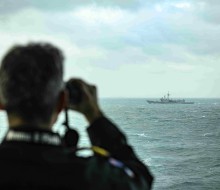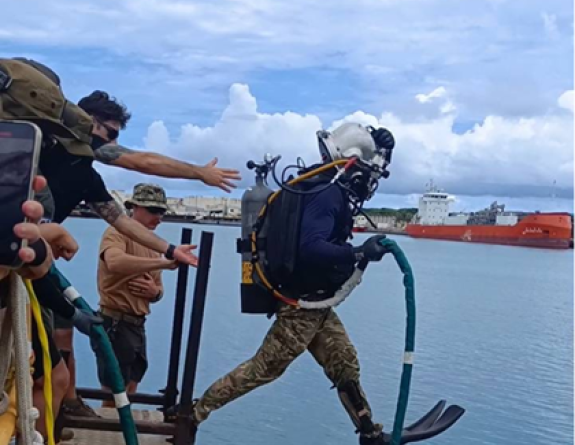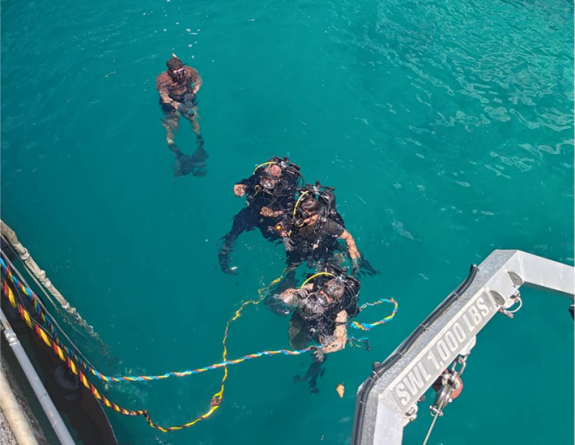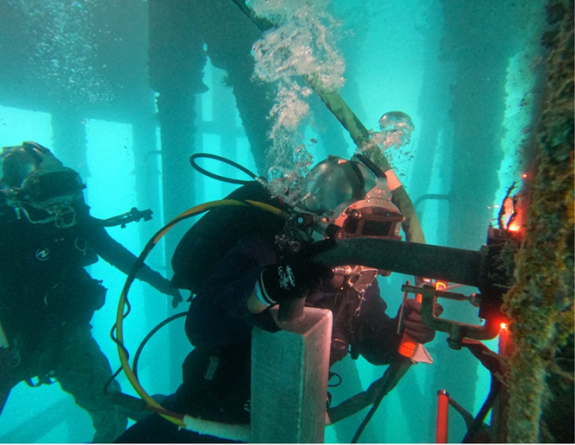
NZDF bolsters North Korea sanctions enforcement with HMNZS Aotearoa and P-8A Poseidon
08 December 2025
Unfortunately you are viewing this website on an outdated browser which does not support the necessary features for us to provide an adequate experience. Please switch to a modern browser such as latest version of Google Chrome, Mozilla Firefox, Apple Safari or Microsoft Edge.
Ngā mihi nui
Welding, bolting and construction – it gets a lot more complex when it’s underwater.
A team of 11 divers from HMNZS Matataua have just returned from a two-week training exercise in Guam, tackling underwater construction tasks alongside US Navy and Republic of Korea divers.
Exercise Mureng (Multinational Underwater Repair Engagement) is designed to test and improve the interoperability and skills of military divers and underwater construction teams.
Officer in Charge, Lieutenant John Duncan, says military divers are trained in welding, and an overseas exercise with partners provides an excellent opportunity to demonstrate their skills.
The exercise involved real time pier maintenance tasks. The teams undertook inspections on the main fueling pier at Naval Base Guam, using a marine growth removal tool called a “barnacle buster” to remove built-up encrustation.
A weightier task involved welding and bolting replacement zinc anodes to the pier, at 1.6 metres in length and weighing 60kg. Metals in saltwater are naturally electrically reactive and will corrode, so zinc blocks – a far more reactive metal than the pier fittings – are used as a more attractive ‘sacrifice’ to prevent other metals being eaten away.
The team undertook buoy inspections, following the chain down from buoy to the mooring on the sea floor and checking for wear and tear.



Divers equipped with surface-supplied breathing apparatus undertake engineering tasks on a fuelling pier in Guam.
While it sounds more like custodial maintenance, the tasks provide training in two kinds of diving: scuba for mooring inspections and ‘surface-supplied’ diving for tasks involving concentrated engineering and hydraulic tool tasks.
Outside of these tasks, the team also had the opportunity to test their maritime explosive ordnance disposal expertise by participating in a US Navy-led underwater demolition exercise.
Lieutenant Duncan says wharf infrastructure maintenance and repair are core skillsets for Matataua’s clearance divers.
“These tasks are conducted in a similar way as they would be on the surface however, when overlaid with diving they become inherently more complex and require particular attention to detail to ensure they are completed safely to achieve the desired effect,” he says.
“It’s a capability we train for, but it’s not something we routinely get to practise in New Zealand. So this exercise provided an amazing opportunity to train with our partners and further develop some of the many skills required of a clearance diver.”